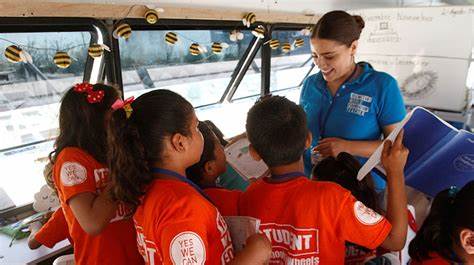(单词翻译:单击)
听力文本
A Bus Becomes a School for Migrant Children
The children sit close together with little space between them. They study their notes, books and papers at desks where once there had been passenger seats.
A teacher has hung their work from the storage area above their heads: colorful alphabet letters, and paintings.
The bus is in Tijuana, Mexico, just a few kilometers from the border with the United States. The bus is next to a migrant shelter. It offers a chance for Central American and Mexican children to attend school.
Several dozen students have taken part in the program since it began in July. For most of them, education was a distant dream in the weeks or months since their parents decided to leave their homes and travel north to seek refuge or a better life.
Estefania Rebellon is director of the program, called Yes We Can. She said it offers special education for children who may have low reading and writing abilities and struggle with social skills. The classes are bilingual, meaning they are taught both in Spanish and English.
The program seeks to provide a level of security too.
"These are children from very dangerous areas, where they have very big issues with trust," she said.
Recently, 22 people were killed in a shooting at a Walmart store in El Paso, Texas, including eight Mexicans. Police said the gunman was angry about immigration. But Rebellon said the violence that these students have seen in their home countries was likely worse.
She said it was upsetting that vulnerable people could not count on finding safety in the United States.
Rebellon, who also works as an actress in Los Angeles, said she knows what it is like to feel lost as a migrant child. When she was 10 years old, she moved to Miami, Florida, from Colombia, where her parents had received death threats.
School became her refuge, or safe place.

When she saw large groups of Central American migrants arriving in Tijuana late last year, she launched a school program for children in at a large shelter.
She got the idea to use an old bus as a school from the "tiny home movement”—that supports living in small homes.
Rebellon's bus used to fit 55 people - but with the insides removed, it now seats 80 children.
The bus has welcomed 37 students ages five to 12 since the program opened. It will take in another 20 children in the coming weeks. Yes We Can will also launch a program for teenagers in tents outside, Rebellon said.
The three teachers are accredited in Mexico. They have experience working with displaced children in Latin America.
Yes We Can is working to bring on a fourth teacher who speaks two native languages, in addition to Spanish and English.
Most of the children are from families that are in Tijuana for weeks or months. They are waiting to seek asylum in the United States.
They come from Honduras, El Salvador and Guatemala. They also come from the Mexican cities of Guerrero, Michoacan and Leon, where people often fear getting caught in gunfire between illegal drug groups.
Rebellon said parents from those cities have told her that teachers often refuse to show up at school because they fear getting killed or kidnapped. Some children have missed school for several months.
With more money, Rebellon said she would like to expand to other border cities with growing migrant populations.
"We can be in a bus, in a house, in a boat," she said. "It's more about what we teach the children."
I’m Anne Ball.
重点解析
重点讲解:
1. be next to 紧邻;毗连;
You must be next to me, try to understand me and to help me as I did it when you started living.
你要紧挨着我,试着理解我,帮助我,就像你刚成长时我对你那样。
2. struggle with 与......斗争;和......斗争;
He is currently locked in a power struggle with his Prime Minister.
他目前陷入了一场同总理的权力之争当中。
3. count on 指望;期望;
I can always count on you to cheer me up.
你总能使我振作起来。
4. expand to 扩大为;扩展到;
This requirement will gradually expand to include smaller public companies in the future.
这一要求将在未来逐步扩展到包含更小的国有公司。
参考译文
巴士变成流动儿童的学校
孩子们坐得很近,彼此之间的空间很小。他们在桌子上研习笔记、书籍和文件,这些地方曾经装有乘客座椅。
一位老师把储藏区中学生的作品挂在头顶上方:彩色字母和绘画。
这辆巴士停在墨西哥的提华纳,离美国边境只有几公里。巴士紧挨着一个移民收容所,它为中美洲和墨西哥儿童提供了上学的机会。
从7月份开始,已有几十名学生参加了这个项目。对他们大多数人来说,教育是一个遥远的梦想,在数周或数月后,他们的父母决定离家,向北出发寻求庇护或更好的生活。
艾斯特法尼亚·雷韦利翁是“Yes We Can”项目的主管,她说,这项计划为那些读写能力差、不善社交的儿童提供特殊教育。这些课程为双语授课,也就是说老师用西班牙语和英语讲课。
该计划也寻求提供一定程度的安全保障。
她说:“这些孩子来自非常危险的地区,他们在信任方面存在很大的问题。”
最近,在德克萨斯州埃尔帕索的沃尔玛商店发生枪击事件,22人丧生,其中包括8名墨西哥人。警方说枪手对移民感到气愤。但雷韦利翁说,这些学生在本国看到的暴力事件可能更严重。
她说,弱势群体不能指望在美国找到安全感,这种情况让人感到不安。
雷韦利翁还在洛杉矶做演员,她说她知道作为一个移民孩子,体会到迷茫是一种什么感觉。她在10岁的时候,父母在哥伦比亚受到死亡的威胁,一家人从哥伦比亚搬到了佛罗里达州的迈阿密。
学校成了她的避难所,或者说是安全的地方。
去年年末的时候,当她看到大批中美洲移民来到提华纳时,她在一个大庇护所启动了一个儿童入学计划。
她从支持小型家庭生活的“小家庭运动”中得到灵感,把一辆旧巴士用作学校。
雷韦利翁的巴士过去可以容纳55名乘客,但因为车内设施都被移走了,现在它可以容纳80个孩子。
自项目开始实施以来,校车迎接了37名5岁至12岁的学生。在接下来的几周里,它会迎来另外20名孩子。“Yes We Can项目还在户外的帐篷里为青少年开启学习项目,” 雷韦利翁说。
项目的三名教师在墨西哥获得认证,他们都拥有在拉丁美洲为流离失所的儿童教课的经验。
除了西班牙语和英语外,“Yes We Can”项目还努力培养第四位讲两种语言的教师。
大多数孩子来自逗留在提华纳数周或数月的家庭,他们正等待在美国寻求庇护。
他们来自洪都拉斯、萨尔瓦多和危地马拉,还有来自墨西哥的格雷罗、米考坎和利昂。在那些地方,人们常常害怕卷入非法毒品集团之间展开的枪战。
雷韦利翁表示,来自这些城市的家长告诉她,老师们经常拒绝上学,因为他们害怕被杀或遭绑架。有些孩子都几个月没上学了。
有了更多的资金,雷韦利翁表示她想扩展到其他移民人口不断增加的边境城市。
她说:“我们可以在公车、房子和船里上课,我们教给孩子们的知识更重要。”
安妮·鲍尔报道。
译文为可可英语翻译,未经授权请勿转载!


